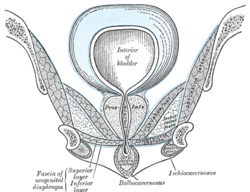| Urogenital diaphragm | |
|---|---|
 | |
 | |
| Details | |
| Artery | Branches of internal pudendal artery |
| Vein | Branches of internal pudendal veins |
| Nerve | Branches of perineal nerve |
| Identifiers | |
| Latin | diaphragma urogenitale |
| Anatomical terminology | |
Older texts have asserted the existence of a urogenital diaphragm, also called the triangular ligament, which was described as a layer of the pelvis that separates the deep perineal sac from the upper pelvis, lying between the inferior fascia of the urogenital diaphragm (perineal membrane) and superior fascia of the urogenital diaphragm.
While this term is used to refer to a layer of the pelvis that separates the deep perineal sac from the upper pelvis, such a discrete border of the sac probably does not exist.[1][2][3][4][5]
While it has no official entry in Terminologia Anatomica, the term is still used occasionally to describe the muscular components of the deep perineal pouch. The urethra and the vagina, though part of the pouch, are usually said to be passing through the urogenital diaphragm, rather than part of the diaphragm itself.[2]
Some researchers still assert that such a diaphragm exists,[6] and the term is still used in the literature.[7]
The urethral diaphragm is an anatomic landmark used in radiologic and urologic classification of urethral injury. Specifically, when a retrograde urethrogram demonstrates extension of contrast from the proximal bulbous urethra into the perineum, there is an increase of grading of the injury from a Type 2 to a Type 3 classification.
The term "urogenital diaphragm" is often confused with the pelvic diaphragm (pelvic floor), which is a true diaphragm supporting many of the pelvic organs.[8]
References
[edit]- ^ Kaye K, Milne N, Creed K, van der Werf B (1997). "The 'urogenital diaphragm', external urethral sphincter and radical prostatectomy". ANZ Journal of Surgery. 67 (1): 40–4. doi:10.1111/j.1445-2197.1997.tb01892.x. PMID 9033375.
- ^ a b "Chapter 38: The perineal region and external genitalia". Retrieved 2007-12-09.
- ^ Oelrich TM (1980). "The urethral sphincter muscle in the male" (PDF). Am. J. Anat. 158 (2): 229–46. doi:10.1002/aja.1001580211. hdl:2027.42/49683. PMID 7416058.
- ^ Mirilas P, Skandalakis JE (2004). "Urogenital diaphragm: an erroneous concept casting its shadow over the sphincter urethrae and deep perineal space". J. Am. Coll. Surg. 198 (2): 279–90. doi:10.1016/j.jamcollsurg.2003.07.022. PMID 14759786.
- ^ Dorschner W, Biesold M, Schmidt F, Stolzenburg JU (1999). "The dispute about the external sphincter and the urogenital diaphragm". J. Urol. 162 (6): 1942–5. doi:10.1016/S0022-5347(05)68074-3. PMID 10569543.
- ^ Herschorn S (2004). "Female pelvic floor anatomy: the pelvic floor, supporting structures, and pelvic organs". Rev Urol. 6 Suppl 5: S2–S10. PMC 1472875. PMID 16985905.
- ^ Hruby S, Ebmer J, Dellon AL, Aszmann OC (2005). "Anatomy of pudendal nerve at urogenital diaphragm--new critical site for nerve entrapment". Urology. 66 (5): 949–52. doi:10.1016/j.urology.2005.05.032. PMID 16286101.
- ^ Maclean, Allan; Reid, Wendy (2011). "40". In Shaw, Robert (ed.). Gynaecology. Edinburgh New York: Churchill Livingstone/Elsevier. pp. 599–612. ISBN 978-0-7020-3120-5; Access provided by the University of Pittsburgh
((cite book)): CS1 maint: postscript (link)
| Perineum |
| ||||||||||||||
|---|---|---|---|---|---|---|---|---|---|---|---|---|---|---|---|
| Fascia |
| ||||||||||||||